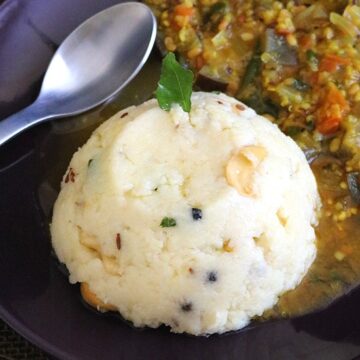
Rava Pongal
Rava Pongal is an extremely simple yet super flavorful, healthy and delicious South Indian breakfast made from sooji/semolina and moong dal.
Ingredients
- ¼ Cup Moong Dal
- 1 + 1 ½ Cups Water
- ¼ Cup Milk (Optional)
- ¾ tsp Salt (adjust per taste)
- ½ Cup Rava | Semolina
To temper
- 1 Tbsp Ghee
- 1 tsp Ginger (finely chopped)
- 10 Cashews
- 2 tsp Pepper
- 2 tsp Jeera
- 1 sprig Curry leaves
- ⅛ tsp Asafoetida
Instructions
- First, add the moog dal along with 1 Cup of water to a pressure cooker. Pressure cook until moong dal is fully done. I kept for 2 whistles.
<br><br><img src="//revisfoodography.com/wp-content/uploads/2017/03/rapo-1.jpg" alt="pongal" width="48%" /> <img src="//revisfoodography.com/wp-content/uploads/2017/03/rapo-2.jpg" alt="pongal" width="48%" /> - Once the pressure subsides, remove the lid and mash the dal. Now add the remaining 1 ½ Cups of water and the ¼ Cup of milk. Mix well and let them come to a boil.
<br><br><img src="//revisfoodography.com/wp-content/uploads/2017/03/rapo-3.jpg" alt="pongal" width="48%" /> <img src="//revisfoodography.com/wp-content/uploads/2017/03/rapo-4.jpg" alt="pongal" width="48%" /> - Now, add the salt and rava to the pan. Keep stirring continuously until the rava is fully cooked. Turn off the flame.
<br><br><img src="//revisfoodography.com/wp-content/uploads/2017/03/rapo-5.jpg" alt="pongal" width="48%" /> <img src="//revisfoodography.com/wp-content/uploads/2017/03/rapo-6.jpg" alt="pongal" width="48%" /><br><br><img src="//revisfoodography.com/wp-content/uploads/2017/03/rapo-7.jpg" alt="pongal" width="48%" /> <img src="//revisfoodography.com/wp-content/uploads/2017/03/rapo-8.jpg" alt="pongal" width="48%" /> - In a separate pan, heat the ghee and add the ingredients listed under "To temper". Saute until the cashews turn golden brown.
<br><br><img src="//revisfoodography.com/wp-content/uploads/2017/03/rapo-9.jpg" alt="pongal" width="48%" /> <img src="//revisfoodography.com/wp-content/uploads/2017/03/rapo-10.jpg" alt="pongal" width="48%" /><br><br><img src="//revisfoodography.com/wp-content/uploads/2017/03/rapo-11.jpg" alt="pongal" width="48%" /> <img src="//revisfoodography.com/wp-content/uploads/2017/03/rapo-12.jpg" alt="pongal" width="48%" /> - Add the tempering to the cooked rava and mix well until everything is combined.
<br><br><img src="//revisfoodography.com/wp-content/uploads/2017/03/rapo-13.jpg" alt="pongal" width="48%" /> <img src="//revisfoodography.com/wp-content/uploads/2017/03/rapo-14.jpg" alt="pongal" width="48%" /> - Serve hot with chutney / sambar.
<br><br><img src="//revisfoodography.com/wp-content/uploads/2017/03/rava-pongal-1.jpg" alt="rava pongal" width="100%" /> <img src="//revisfoodography.com/wp-content/uploads/2017/03/rava-pongal-2.jpg" alt="rava pongal" width="100%" /> <img src="//revisfoodography.com/wp-content/uploads/2017/03/rava-pongal-3.jpg" alt="rava pongal" width="100%" />
Notes | FAQ
- I used a roasted rava. If your rava is not already roasted, you will have to dry roast it first before using.
- Adjust the quantity of water based on the type of rava you are using. The rava I use typically requires more water to cook.
- Vegans can skip the milk and instead of ghee can add vanaspati / coconut oil. However the flavor would differ.
- Adjust the quantity of water based on the type of rava you are using. The rava I use typically requires more water to cook.
- Vegans can skip the milk and instead of ghee can add vanaspati / coconut oil. However the flavor would differ.